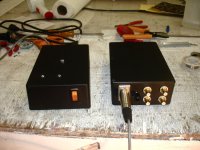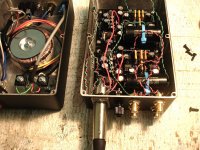Hahooo! Phonoclone!
Finished and sounding great!...pretty much your standard unit the only changes from the BOM was Mundorf M-Cap supreme output caps, the 100Uf caps were upgraded to Nichion Muse (a little bigger but still doable, don't try Muse in the 1000Uf slot as they are too big) and I used some sheilded cable from the tranformer unit.. looking forward to some good times,
Thanks for all your help.
Cheers
Finished and sounding great!...pretty much your standard unit the only changes from the BOM was Mundorf M-Cap supreme output caps, the 100Uf caps were upgraded to Nichion Muse (a little bigger but still doable, don't try Muse in the 1000Uf slot as they are too big) and I used some sheilded cable from the tranformer unit.. looking forward to some good times,
Thanks for all your help.
Cheers
Attachments
@simonov
Nice work, from what I can tell from the very small photo you posted... it looks like a stereo VSPS.
Richard
Yes you are quite right.
p.s. I'm using a external link to the image. I'm not quite sure why it shows this way
Regards,
Venci
Ok, I messed up 
I mis-wired the V-- line coming off the bridge rectifiers, pumping V++ into the V--- input on the VSPS. The electrolytic cap that came with the kit blew up in my face before I could get everything unplugged, so I'll obviously be replacing that.
My only concern at this point is whether or not I damaged anything else on the board. Would the damage have stopped at the cap, or am I going to end up ordering another kit instead of desoldering and testing each component?
I mis-wired the V-- line coming off the bridge rectifiers, pumping V++ into the V--- input on the VSPS. The electrolytic cap that came with the kit blew up in my face before I could get everything unplugged, so I'll obviously be replacing that.
My only concern at this point is whether or not I damaged anything else on the board. Would the damage have stopped at the cap, or am I going to end up ordering another kit instead of desoldering and testing each component?
@CognitiveDiscord
For stereo VSPS: the regulator should have blocked the voltages from the rest of the circuit. Chances are good that all you have to replace is the two 1000uF caps. (I assume that you had both V-- and V++ wired backwards when you switched on.)
Try that and if it works, fine. If for whatever reason it does not, then for the price of a new kit vs. the time and trouble of checking everything on the old board, new kit, no question. Salvage C3 to use on another project, since those are useful, easy to remove, and guaranteed to be undamaged by the mistake.
@fiftyfivefilms
Very nice. You clearly paid close attention to to the instructions. It looks just like mine!
For stereo VSPS: the regulator should have blocked the voltages from the rest of the circuit. Chances are good that all you have to replace is the two 1000uF caps. (I assume that you had both V-- and V++ wired backwards when you switched on.)
Try that and if it works, fine. If for whatever reason it does not, then for the price of a new kit vs. the time and trouble of checking everything on the old board, new kit, no question. Salvage C3 to use on another project, since those are useful, easy to remove, and guaranteed to be undamaged by the mistake.
@fiftyfivefilms
Very nice. You clearly paid close attention to to the instructions. It looks just like mine!
In ordering the replacement caps, I figured I would go ahead and order the improved accuracy resistors (732k, etc). You noted that they weren't available in carbon-film, and to not bother , but I was curios as to why. What's the issue with carbon film vs metal film resistors? You also noted that "Unless the capacitors are within 1% of the list value there is no point worrying about the extra accuracy of the resistors".
As a side note, does anyone know where I can find a reasonably priced multimeter or device that can measure capacitance above 200uf? (I have a $40 multimeter that goes up to that)
Thanks again guys, I know I'm laying the questions on thick. I'm starting to get the hang of this, though!
As a side note, does anyone know where I can find a reasonably priced multimeter or device that can measure capacitance above 200uf? (I have a $40 multimeter that goes up to that)
Thanks again guys, I know I'm laying the questions on thick. I'm starting to get the hang of this, though!
If both the resistors and the capacitors are each +-5% then the tolerance of the RIAA settings will be +-10%.
If you use improved tolerance resistors of, say +-1%, then your RIAA becomes +-6%.
If you used 0.5% resistors and 2% capacitors then your accuracy improves to +-2.5%. That's 4 times tighter than using +-5% for all
If you use improved tolerance resistors of, say +-1%, then your RIAA becomes +-6%.
If you used 0.5% resistors and 2% capacitors then your accuracy improves to +-2.5%. That's 4 times tighter than using +-5% for all
Backstory-
People were asking me if they should use 0.1% resistors for the RIAA. I said no, there's no point, since the capacitors are only accurate to 5% anyway. (See Andrew's argument, above).
Also, the BOM values are a couple of percent off the theoretically true RIAA eq. So even +-0% tolerance parts would not be 100% accurate.
In practice you have two choices:
1. Just solder in the parts and forget about it, it'll be close enough.
2. Measure and match the (5%) capacitors so C1 and C2 are the same for both channels, even if they are not the exact BOM (or RIAA) values. It's more important to match channels than it is to be exactly on the RIAA eq, and you'll be close to that anyway (see 1., above).
People were asking me if they should use 0.1% resistors for the RIAA. I said no, there's no point, since the capacitors are only accurate to 5% anyway. (See Andrew's argument, above).
Also, the BOM values are a couple of percent off the theoretically true RIAA eq. So even +-0% tolerance parts would not be 100% accurate.
In practice you have two choices:
1. Just solder in the parts and forget about it, it'll be close enough.
2. Measure and match the (5%) capacitors so C1 and C2 are the same for both channels, even if they are not the exact BOM (or RIAA) values. It's more important to match channels than it is to be exactly on the RIAA eq, and you'll be close to that anyway (see 1., above).
Well, (thanks to this board) this afternoon I listened to the first vinyl I have had the pleasure to spin since we moved six years ago. I finished building and testing the VSPS (I've had the PC board for over two years), hooked it up between my old Rega deck and AV receiver, pulled a disc out of a packing case and sat back to listen to the sweet analog goodness.

Initial reviews are favorable, but it still needs some burn-in. Pictures and opinions to follow. Next step is to get the ADC setup and start ripping those albums to digital (while enjoying revisiting a lot of old music that I have not heard in ages).
Thanks to RJM and others on this forum for the design and all the help.
-bill
PS. Deck is an old UK sourced Rega Planar-2 w/ original motor, arm is an Origin Live RB250, cartridge is a Grado Blue. No sign of hum.
Initial reviews are favorable, but it still needs some burn-in. Pictures and opinions to follow. Next step is to get the ADC setup and start ripping those albums to digital (while enjoying revisiting a lot of old music that I have not heard in ages).
Thanks to RJM and others on this forum for the design and all the help.
-bill
PS. Deck is an old UK sourced Rega Planar-2 w/ original motor, arm is an Origin Live RB250, cartridge is a Grado Blue. No sign of hum.
Last edited:
Slightly off topic but is there software that will slice and dice the recording into separate files for each track on the album automatically? I ask because doing it by hand is a complete and total turnoff to the otherwise useful task of digitizing some of my records for listening away from my home system...
Hello folks, I recently received my VSPS 300i boards from Richard and I realize I don't really know where to start. I'm going to do the complete BOM from Mouser but I was wondering if anyone has a photo of a stock completed VSPS circuit board they could post? It might help me get tho components installed correctly. I also somewhere thought I have seen a diagram of the installed components that might be helpful. Richard has been extremely helpful but couldn't help with the photo.
Thanks in advance.
WntrMute2
Thanks in advance.
WntrMute2
Slightly off topic but is there software that will slice and dice the recording into separate files for each track on the album automatically? I ask because doing it by hand is a complete and total turnoff to the otherwise useful task of digitizing some of my records for listening away from my home system...
RJM, what you want is, of course, complicated.
WavePad (for the Mac, not sure about PC) has an auto-split function that will split a recording based on a user specified noise floor for a specified duration. This will do what you want...mostly. Other programs may do similarly. Audacity, my favorite, has a "Silence Finder option (part of the Nyquist plugins) which will place markers and labels in silence areas.
But if you have silence in the midst of a track (I have several of these), it will probably think there are two tracks instead of one. Similarly, where two tracks have no silence between them, you will not have any split occurring. Then there is the issue of severely noisy albums (I have one or two first or second pressing Beatles like this), where the inter-track silence just isn't silent any more. Not sure a proper noise floor could be established in these cases.
In short, you could try something like WavePad or Audacity, but you may still have to do a lot of work to properly split your recordings.
- Home
- Source & Line
- Analogue Source
- The Phonoclone and VSPS PCB Help Desk


